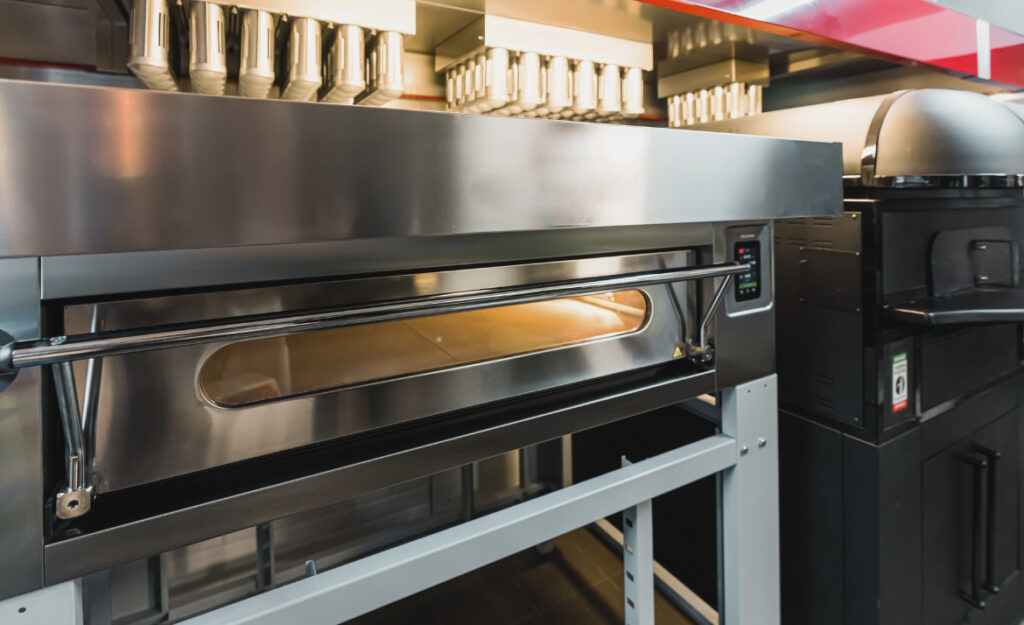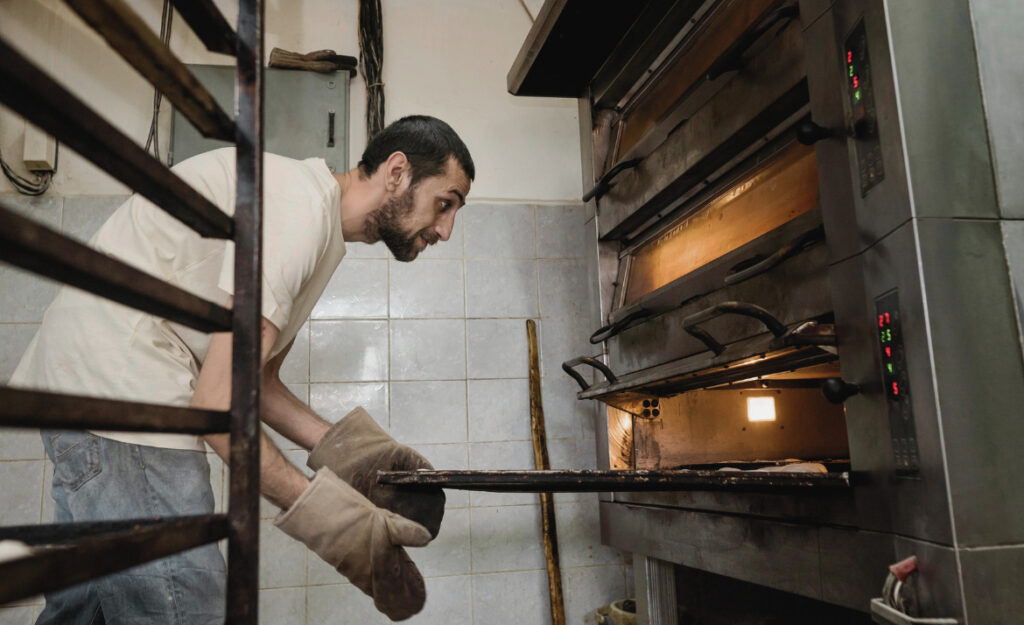
Every industrial kitchen faces the inevitable: thick layers of oven grease that mock everyday cleaning efforts. Even skilled staff find themselves pausing, hands on hips, wondering what it’ll take to finally clean stubborn oven grease and restore that gleaming surface.
Grease isn’t just an eyesore—it’s a real safety concern. Unchecked, it leads to smoldering smells, uneven baking, and creates fire hazards. These realities make grease removal an urgent priority, not just another optional cleaning task in commercial food service settings.
Dig into this article for chef-level cleaning strategies. From prepping your workspace to proven industrial methods, you’ll learn how to tackle even the most baked-on grease so your oven performs (and looks) its best.
Starting Right: Set Up for Effortless Grease Removal
Prepare the right way, and every other step becomes easier. A good prep routine saves time, protects surfaces, and minimizes downtime in a busy industrial kitchen.
Before you clean stubborn oven grease, let the oven cool fully. Pull racks, mats, and trays. Place a drop cloth or disposable sheet on the floor. Gather gloves, sponges, plastic scrapers, and your cleaning agents—everything within arm’s reach prevents messy delays.
Prepping Work Zones for Speed and Safety
Staff say, “I lay out my gear before starting—gloves, spatula, degreaser. Less movement means fewer spills.” This becomes a habit in high-pressure kitchens, streamlining every tricky cleanup.
Builders mark zones with tape or a mat, outlining where tools and supplies stay. Borrow this trick: an organized zone keeps chemicals away from prep surfaces and prevents cross-contamination during cleaning breaks.
Wear long sleeves, splash-resistant gloves, and even safety goggles if grease build-up’s severe. Strong de-greasers can irritate skin, and a little preparation avoids unpleasant surprises every time you wipe down.
Checklist: What to Keep On Hand
A thorough cleaning session relies on the right gear. Keep these items in an accessible spot:
| Item | Use Case | Best For | Action Step |
|---|---|---|---|
| Plastic Scraper | Removing burnt-on grease | Corners, edges | Hold at low angle, push gently |
| Degreasing Spray | Breaking down fatty deposits | Heavy stains | Apply, wait 10 minutes |
| Non-scratch Pad | Scouring without damage | Glass, enamel | Use circular motions |
| Baking Soda | Absorbing spill residue | Light cleaning | Sprinkle before wiping |
| Disposable Cloths | Wiping grime away | All surfaces | Replace frequently |
Timing Your Cleaning for Maximum Efficiency
During mid-shift lulls, clean one oven section while staff focuses on other prep. This avoids traffic jams. Keep a timer handy so cleaning agents penetrate just long enough—too brief, and the grease wins.
Some team leaders schedule deep cleans for just before dusk, when the kitchen is warm but demand is low. Consistent timing forms better habits and keeps grease from hardening further.
If something delays your schedule, cover surface stains with a moist towel until you return. This tricks grease into softening, minimizing elbow grease when you tackle it later.
Best Degreasers and Safe Alternatives at Your Fingertips
Chefs share a rule: Use the strongest safe option first, but always test in an inconspicuous spot. Good degreasers clean stubborn oven grease without damaging oven coatings.
Commercially approved products excel on heavy residue, but eco-friendly mixtures can tackle moderate buildup between deep cleans. Know when each delivers best results, and select accordingly for your kitchen’s priorities.
Quick-Check: Eco Solutions for Daily Use
Baking soda mixed with vinegar is a reliable standby in industrial kitchens. Sprinkle soda, spritz vinegar, let it fizz, and mop away after ten minutes; the reaction loosens surface grease fast.
- Apply baking soda with a spoon for even coverage—prevents missed spots and wasted powder.
- Use a reusable spray bottle for vinegar—keeps application precise, never wasteful.
- Wipe with a folded cloth to control pressure—reduces smears and streaks.
- Let mixtures sit for full contact; rushing leads to double work later.
- Rinse with warm water to finish—clears away loosened residue before it re-hardens.
Using this method between professional cleans promotes food-safe surfaces and lessens final scrubbing time.
Industrial Degreasers: When and How to Use Them
Apply gel-style commercial degreaser to thickest spots first, then work outward. Waiting the full labeled time is essential—premature wiping breaks greasy bonds, leaving residue behind.
- Follow manufacturer’s timing—don’t shortchange the soak, even during a rush.
- Scrape only after degreaser has gone cloudy—clear gel means more time is needed.
- Rinse with two passes: one with a damp sponge, another with a wrung-out towel for no streaks.
- Ventilate area throughout—strong fumes can linger, especially in closed kitchen spaces.
- Switch to a gentler cleaner for sensitive oven sections like gasket molds.
After using any industrial degreaser, complete a food-safe rinse cycle—leave no chemical traces for the next service shift.
Tactics for Removing Burnt-On, Baked-In Grease
Scraped grease saves time later. Success cleaning stubborn oven grease depends on patient step-by-step effort with every pass. Try these tested tactics in your kitchen:
Use plastic scrapers, followed by a stiff-bristled brush to get into seams and ridges. Dampened stains respond to short strokes, not forceful rubbing. If you hear squeaking, slow down—let the tools do the work.
Stubborn Corners and Hidden Spots
Cooks whisper, “Never skip the corners, that’s where inspectors check first.” Tuck a cloth-wrapped chopstick into narrow seams and wipe methodically. Inspective staff lean in, using flashlights or phone lights, looking for forgotten globs. Copy that attention to detail every session.
Use a toothpick for vent holes, twirling gently. For glass inner doors, tilt the oven light towards trouble spots; residue glows yellow. Match your movements to the shapes and angles—don’t try brute force straight across flat spaces.
Pretend grease is a fingerprint at a crime scene: it hides, smears, and lingers. Find every trace by changing your viewing angle as you clean, spotting gleams and streaks that simple head-on wipes can’t catch.
Working in Sequence for Full Coverage
Seasoned kitchen crew start at the top, moving down in slow, controlled passes—this gravity-driven approach pushes loose residue onto the next area instead of back over newly-cleaned spaces. Always work side to side, never random dabs, for thorough breakdown.
Treat doors last: close only when all interior sections are done. Any leftover cleaner behind glass seals can cloud or re-bake if sealed in. Run a checklist: ceiling, racks, sidewalls, then bottom tray—no zones skipped, no effort wasted.
Pair up: one cleans, the other inspects gaps and gives quick tips. “You missed a streak here, look from the other angle.” Tag-teaming keeps everyone alert and guarantees no grease is left behind for the next team member.
Routine Schedules That Prevent Grease Buildup
Maintaining a schedule in an industrial kitchen reduces workload and extends oven life. Clean stubborn oven grease less painfully by blocking out regular times, not just waiting for grime to accumulate.
Daily wipe-downs after final service, weekly deep cleans, and monthly maintenance save hours later. Track with a wall calendar or digital checklist, noting every cleaning session so every team member stays accountable.
Integrating Cleaning with Kitchen Workflow
Assign cleaning roles before the shift starts—make it as standard as prepping ingredients. Cooks say out loud, “Oven check before clocking out.” This spoken routine builds professional pride and keeps standards high without nagging.
Prepare a visible schedule that marks ‘deep clean’ days in red. Busy teams see it at a glance and never miss essential kitchen care duties. Rotate cleaning leads each week for a sense of shared responsibility among all staff levels.
If an emergency service interrupts the process, log which steps remain. Next shift catches up exactly where needed, avoiding duplicated or skipped areas. This documentation keeps standards consistent through staff changes or busy periods.
Critical Zones: Focusing Attention for Best Results
For chefs and managers, sharp attention to detail ensures nothing is missed when cleaning stubborn oven grease. Review these high-priority areas and match each with a repeatable approach:
Door seals, fan blades, heating elements, and corners are the most neglected zones. Use a flashlight for close inspection and check surfaces from multiple angles. Document each zone’s last cleaning—this prevents accidental misses over time.
Final Thoughts on Professional-Grade Cleaning
Industrial kitchens demand rigorous standards. Familiarity with smart preparation, safe products, and a strategy for tough stains makes every team’s job easier. These routines help to clean stubborn oven grease while protecting staff and equipment alike.
When multiple team members stay alert and share responsibility for these tasks, the kitchen works smoothly and safely. Staff morale improves, full-point inspections happen more often, and ovens last considerably longer under consistent care.
Carry this knowledge forward. Every session spent on smart grease removal pays dividends in safety, equipment life, and presentation—benefits that owners, employees, and guests all enjoy for the long run.
Frequently Asked Questions
What is the fastest way to clean stubborn oven grease in an industrial setting?
Use a high-quality commercial degreaser, let it soak for the labeled time, then scrape gently with a plastic scraper. Finish with two rinse passes to ensure no residue is left. Always ventilate the area while cleaning industrial ovens.
How often should industrial ovens be cleaned to prevent hard grease buildup?
Do a daily wipe-down after your final shift, deep cleans weekly, and a thorough overhaul monthly. Regular scheduling maintains performance and minimizes long-term buildup or fire risk. Mark completed cleans on a visible calendar for accountability.
Are homemade solutions effective for heavy, industrial kitchen grease?
Baking soda and vinegar work on moderate stains, but heavy, stubborn grease in industrial settings may require designated degreasers formulated for thick deposits. For best safety and effectiveness, alternate eco-friendly and commercial treatments.
Is scraping necessary every time, or can soaking alone remove stubborn oven grease?
Soaking softens most deposits, but scraping is essential for burnt-on or sticky spots, especially in seams and corners. Use plastic scrapers to avoid damaging surfaces and always follow with a wipe-down to remove loosened residue.
What’s the best protection for staff during industrial oven cleaning?
Wear long-sleeved shirts, splash-resistant gloves, and safety goggles if using harsh chemicals. Ventilate your work area thoroughly, and have a spill kit nearby for unexpected chemical splashes. Develop these protective habits as part of your kitchen’s cleaning routine.



